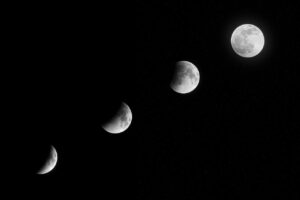For centuries, the moon has fascinated humanity with its mysterious beauty and ethereal presence in the night sky. But its influence goes far beyond aesthetics. The impact of the moon on Earth is profound. From shaping ocean tides to inspiring myths and legends, the moon’s effect is both scientific and cultural.
Tides and Gravitational Pull
The impact of the moon on life on Earth is significant, particularly in the form of tides. Through its gravitational pull, along with the sun’s gravity, the moon causes the ebb and flow of ocean tides. This phenomenon, known as tidal forces, occurs because the moon’s gravitational attraction is stronger on the side of Earth facing the moon. As a result, this creates an elevated point in ocean waters, leading to high tide. On the opposite side of Earth, there is another bulge caused by the centrifugal force within the Earth-moon system, resulting in a second high tide. The areas between these points experience low tide.
Tidal patterns have important implications for the environment and ecology. Coastal ecosystems, like estuaries and tidal flats, rely on the regular tides to circulate nutrients and support species survival. In addition, tides impact navigation, fishing activities, and planning of coastal infrastructure.
Cultural Significance
The moon has cultural significance that extends beyond its scientific impact. It has served as a source of inspiration for myths, legends, and religious beliefs in many different cultures. For instance, in ancient Greek mythology, the moon goddess Selene was seen as a representation of the moon’s beauty and enigma. In Hinduism, the moon god Chandra is highly revered and symbolizes the mind and emotions.
The moon holds immense significance in various cultural calendars, helping determine the dates of religious festivals and traditional practices related to agriculture. For centuries, lunar phases such as the full moon and new moon have served as markers of time, guiding human activities and events.
Human Exploration and Scientific Research
For decades, humans have been fascinated by and actively exploring the moon. The Apollo program, launched by NASA in the 1960s, achieved the remarkable feat of landing astronauts on its surface, uncovering invaluable knowledge about lunar geology and the origins of our solar system. Today, various countries like China and India are still actively conducting lunar missions to further study the moon’s surface, composition, and potential resources.
Studying the moon goes beyond mere curiosity as it holds crucial implications for space exploration and resource usage. Scientists are keen on using the moon as a launchpad for future human expeditions to Mars and other celestial bodies. Furthermore, there is the potential of finding vital resources such as water ice on the moon, which could prove invaluable for supporting life in space and manufacturing rocket fuel.
Natural Cycles and Biological Rhythms

The moon’s impact extends beyond the tides. In the natural world, there are observable behaviors in some animals that align with lunar cycles. For instance, certain species of fish and birds time their migrations and breeding based on the illumination from the moon. Interestingly, even humans have been found to experience fluctuations in sleep patterns and moods that correspond with different phases of the moon. However, it should be noted that scientific consensus on this matter is still inconclusive.
The Impact of the Moon on Earth is Synonymous to Life
The impact of the moon on life here on Earth is extensive, encompassing scientific, cultural, and ecological dimensions. It influences tides through gravitational forces and shapes our cultural beliefs and calendars. As we explore and study this celestial neighbor further, our understanding of our planet and our place in the universe deepens. The moon’s presence in our night sky continuously evokes awe and curiosity, serving as a constant reminder of the intricate connections between Earth and the vast cosmos.